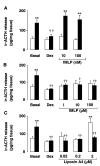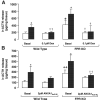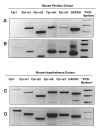Formyl peptide receptors and the regulation of ACTH secretion: targets for annexin A1, lipoxins, and bacterial peptides
- PMID: 17218541
- PMCID: PMC1892899
- DOI: 10.1096/fj.06-7299com
Formyl peptide receptors and the regulation of ACTH secretion: targets for annexin A1, lipoxins, and bacterial peptides
Abstract
The N-formyl peptide receptors (FPRs) are a family of G-protein coupled receptors that respond to proinflammatory N-formylated bacterial peptides (e.g., formyl-Met-Leu-Phe, fMLF) and, thus, contribute to the host response to bacterial infection. Paradoxically, a growing body of evidence suggests that some members of this receptor family may also be targets for certain anti-inflammatory molecules, including annexin A1 (ANXA1), which is an important mediator of glucocorticoid (GC) action. To explore further the potential role of FPRs in mediating ANXA1 actions, we have focused on the pituitary gland, where ANXA1 has a well-defined role as a cell-cell mediator of the inhibitory effects of GCs on the secretion of corticotrophin (ACTH), and used molecular, genetic, and pharmacological approaches to address the question in well-established rodent models. Reverse transcriptase-polymerase chain reaction (RT-PCR) analysis identified mRNAs for four FPR family members in the mouse anterior pituitary gland, Fpr-rs1, Fpr-rs2, Fpr-rs6, and Fpr-rs7. Functional studies confirmed that, like dexamethasone, ANXA1 and two ANXA1-derived peptides (ANXA1(1-188) and ANXA1(Ac2-26)) inhibit the evoked release of ACTH from rodent anterior pituitary tissue in vitro. Fpr1 gene deletion failed to modify the pituitary responses to dexamethasone or ANXA1(Ac2-26). However, lipoxin A4 (LXA4, 0.02-2 microM, a lipid mediator with high affinity for Fpr-rs1) mimicked the inhibitory effects of ANXA1 on ACTH release as also did fMLF in high (1-100 microM) but not lower (10-100 nM) concentrations. Additionally, a nonselective FPR antagonist (Boc1, 100 microM) overcame the effects of dexamethasone, ANXA1(1-188), ANXA1(Ac2-26), fMLF, and LXA4 on ACTH release, although at a lower concentration (50 microM), it was without effect. Together, the results suggest that the actions of ANXA1 in the pituitary gland are independent of Fpr1 but may involve other FPR family members, in particular, Fpr-rs1 or a closely related receptor. They thus provide the first evidence for a role of the FPR family in the regulation of neuroendocrine function.
Figures







Similar articles
-
Anti-inflammatory mechanisms of the annexin A1 protein and its mimetic peptide Ac2-26 in models of ocular inflammation in vivo and in vitro.J Immunol. 2013 Jun 1;190(11):5689-701. doi: 10.4049/jimmunol.1202030. Epub 2013 May 3. J Immunol. 2013. PMID: 23645879
-
Evidence for an anti-inflammatory loop centered on polymorphonuclear leukocyte formyl peptide receptor 2/lipoxin A4 receptor and operative in the inflamed microvasculature.J Immunol. 2011 Apr 15;186(8):4905-14. doi: 10.4049/jimmunol.1003145. Epub 2011 Mar 11. J Immunol. 2011. PMID: 21398608 Free PMC article.
-
Anti-Inflammatory and Pro-Resolving Actions of the N-Terminal Peptides Ac2-26, Ac2-12, and Ac9-25 of Annexin A1 on Conjunctival Goblet Cell Function.Am J Pathol. 2023 Nov;193(11):1817-1832. doi: 10.1016/j.ajpath.2023.05.020. Epub 2023 Jul 7. Am J Pathol. 2023. PMID: 37423551 Free PMC article.
-
Annexin A1 and the formyl peptide receptor family: neuroendocrine and metabolic aspects.Curr Opin Pharmacol. 2008 Dec;8(6):765-76. doi: 10.1016/j.coph.2008.09.005. Epub 2008 Oct 24. Curr Opin Pharmacol. 2008. PMID: 18845272 Review.
-
Novel aspects of annexin 1 and glucocorticoid biology: intersection with nitric oxide and the lipoxin receptor.Inflamm Allergy Drug Targets. 2006 Apr;5(2):107-14. doi: 10.2174/187152806776383170. Inflamm Allergy Drug Targets. 2006. PMID: 16613569 Review.
Cited by
-
Inflammation and cancer: role of annexin A1 and FPR2/ALX in proliferation and metastasis in human laryngeal squamous cell carcinoma.PLoS One. 2014 Dec 9;9(12):e111317. doi: 10.1371/journal.pone.0111317. eCollection 2014. PLoS One. 2014. PMID: 25490767 Free PMC article.
-
Single-Cell Analysis Reveals the Role of the Neuropeptide Receptor FPR2 in Monocytes in Kawasaki Disease: A Bioinformatic Study.Dis Markers. 2022 Jun 1;2022:1666240. doi: 10.1155/2022/1666240. eCollection 2022. Dis Markers. 2022. PMID: 35692878 Free PMC article.
-
Exploiting the Annexin A1 pathway for the development of novel anti-inflammatory therapeutics.Br J Pharmacol. 2009 Oct;158(4):936-46. doi: 10.1111/j.1476-5381.2009.00483.x. Br J Pharmacol. 2009. PMID: 19845684 Free PMC article. Review.
-
Reduced fear memory and anxiety-like behavior in mice lacking formylpeptide receptor 1.Behav Genet. 2011 Sep;41(5):724-33. doi: 10.1007/s10519-011-9467-0. Epub 2011 Apr 12. Behav Genet. 2011. PMID: 21484271 Free PMC article.
-
Cyclosporin H, Boc-MLF and Boc-FLFLF are antagonists that preferentially inhibit activity triggered through the formyl peptide receptor.Inflammation. 2007 Dec;30(6):224-9. doi: 10.1007/s10753-007-9040-4. Epub 2007 Aug 9. Inflammation. 2007. PMID: 17687636
References
-
- Holsboer F, Barden N. Antidepressants and hypothalamic-pituitary-adrenocortical regulation. Endocr. Rev. 1996;17:187–205. - PubMed
-
- Altamura AC, Boin F, Maes M. HPA axis and cytokines dysregulation in schizophrenia: potential implications for the antipsychotic treatment. Eur. Neuropsychopharmacol. 1999;10:1–4. - PubMed
-
- Buckingham JC, Flower RJ. Lipocortin 1: a second messenger of glucocorticoid action in the hypothalamopituitary-adrenocortical axis. Mol. Med. Today. 1997;3:296–302. - PubMed
-
- Theogaraj E, John C, Christian H, Morris J, Smith SF, Buckingham J. Perinatal dexamethasone treatment causes long-term changes in brain ependymal cell morphology and annexin 1 expression in the rat. 2005. [accessed December 18, 2004]. http://www.pa2online.org/Vol2Issue4abst015P.
-
- Taylor AD, Cowell AM, Flower J, Buckingham JC. Lipocortin 1 mediates an early inhibitory action of glucocorticoids on the secretion of ACTH by the rat anterior pituitary gland in vitro. Neuroendocrinology. 1993;58:430–439. - PubMed
Publication types
MeSH terms
Substances
Grants and funding
LinkOut - more resources
Full Text Sources
Research Materials
Miscellaneous

